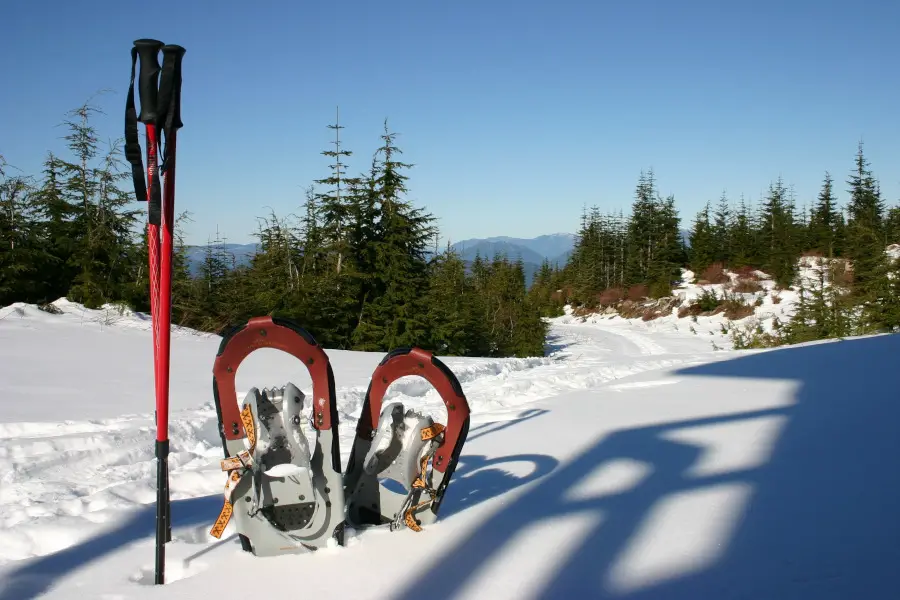Table of Contents
If you are looking for a winter sport that is fun, easy, and inexpensive, then opting for snowshoeing is the way to go. Much like hiking, snowshoeing is an activity that is accessible easily, provided that you have a few key gear items.
Snowshoeing is just about as silent a “silent sport” as you can find. The soft sound of your snowshoes packing the snow and your own heartbeat are about all one can hear as you make your way through the woods in the deep snow.
What is Snowshoeing?
Snowshoeing is a winter hiking activity involving snowshoes that prevent you from sinking and slipping in deep snow by keeping you afloat on the surface. Snowshoers are also aided by adjustable poles with large baskets around the tip to further aid floatation. This silent, safe sport can be done solo or with a group.
Is Snowshoeing Fun?
Snowshoeing is a fun winter sport for a number of reasons. It’s a super way to connect with your friends and family in the great outdoors. Snowshoeing is not a strenous or boring activity, as it involves lots of snow, adventure and breathtaking views.
Another great thing about snowshoeing is that all ages can have fun in the snow with the right kind of snowshoes strapped on. This snowsport is designed for all ability levels, making it a great family activity to enjoy.
Is Snowshoeing Expensive?
Snowshoeing is an inexpensive sport to take part in. Whether you are purchasing snowshoeing gear or simply renting it out, you don’t have to empty your pockets. Renting snowshoeing gear costs you as low as $10, whereas purchasing it will cost you under $100 as well.
When renting or purchasing gear, it is crucial for you to know the type of terrain you want to explore and choose the snowshoe according to that.
All you really need to invest in is snowshoes, and the rest is optional. Snowshoeing gear is nothing you will not already own, and even if it needs to be purchased, especially for the purpose, the expense will not break the bank. Snowshoes, trekking poles, winter clothing, and backpacks are all easily available and at low prices. Therefore, beginners and those unsure of whether they will keep up with the sport have no qualms going out and trying it out once.
How Hard is Snowshoeing?
The best part about snowshoeing is that it is beginner-friendly. All you need to learn is how to stretch your legs wider in order to accommodate the large composite decks of your snowshoes. Everything else in this activity is very intuitive, and you can depend on your instincts for it.
Still, you must know that snowshoeing is a very tough workout. If your body is not conditioned properly for intensive exercise, then you’ll find yourself catching your breath every 15-20 minutes. It is also important for new snowshoers to remember their limits and not exert themselves on their first time snowshoeing.
Moreover, even though snowshoes are made to keep you afloat on the snow, you are bound to sink 1-3 inches deep. It is important for you to strengthen your leg muscles so that it doesn’t become too hard for you to take your legs out of the snow.
Is Snowshoeing a Good Workout?
If you want to stay in shape even when winter arrives and the snow starts to fall, then this activity is what you need. Snowshoeing is an excellent low-impact aerobic exercise that you can enjoy by roaming around with your partner in the cold. This lets you extend your running and hiking season and allows you to enjoy solitude in popular areas that are crowded in the summertime.
Is Snowshoeing Dangerous?
Snowshoeing is a relatively safe sport, just as any outdoor winter sports can be. The primary risk is due to the extreme winter cold which can lead to hypothermia, while knee injuries are also quite common. However, chances of both of these risk factors can be significantly lowered by proper layering of clothes, training and warming-up.
Other risks involve the dangers any unknown terrain could possess. These include the following:
Avalanche Danger Zones
Going snowshoeing can be dangerous, especially if you are snowshoeing backcountry where the risk of avalanches is high. It is important for you to be aware of the warning signs and danger zones in your surroundings.
You should do your research before heading on a trail for snowshoeing.
If active avalanche-prone areas are in your trail, make sure you are properly equipped and have the information you need.

Tree Wells
Tree wells are often overlooked when it comes to mountain hazards but they are as deadly as an avalanche. You should know that tree wells are very dangerous due to SIS (Snow-Immersion Suffocation). A tree well forms when there’s snow accumulation around its base but not around its truck or lower branches.
In order to reduce the chances of undergoing a tree well incident, make sure to follow these tips:
- It is important to ski along with a friend since that increases the chances of survival.
- You must assume that all trees come with tree wells underneath them, even the small ones, and stay away from them.
- Maintain verbal and visual contact with your hiking partner all the time, and if you cannot hear them or see them, you must stop and re-establish contact before moving forward.
- It is a smart idea to have a whistle on your jacket to get their attention in case you end up in the wrong place.
How Much Snow is Needed for Snowshoeing?
You generally need a minimum of 6 inches of snow for safe snowshoeing. Anything less could cause you to stumble in a branch or rock, or even damage your snowshoes. It also depends on the density and humidity of the snow: the more dense and wet the snow is, the more likely it is to hold your weight safely.
Can You Use Snowshoes with Ski Boots?
Technically, you can use snowshoes with ski boots if the ski boots have a walk mode, and they fit the snowshoe bindings. However, it is not recommended to use ski boots with snowshoes since rigid ski boots do not provide the flexibility and the range of movements you need with snowshoes.
How to Keep Snow from Sticking to Snowshoes?
There are a couple DIY methods to avoid snow sticking to your snowshoes. Apply a light layer of candle wax or non-stick cooking spray, or even WD40 on the bottom of your snowshoes to stop the snow sticking.
Can Dogs Go Snowshoeing?
Some dogs are able to handle the cold and snow, however the dog definitely needs to be fit and healthy, as snowshoeing will be a real workout for him or her too. If your dog is obedient and open to snowy adventures, you should start by slowly accommodating him/her to this type of activity.
Where to Go Snowshoeing?
But where does one go to enjoy this increasingly popular winter sport? Unlike cross-country skiing, developed snowshoe trail systems are still evolving across the US and Canada.
Here in northwestern Wisconsin we are fortunate, none the less, to have many excellent places to explore. Of course, the real die-hard adventurer doesn’t even need a trail and can just head out into any tract of undeveloped land. For you, the vast county forests and national forest lands will provide ample opportunity to explore. Existing hiking and nature trails also offer fantastic snowshoeing options, many through deep woods in remote areas; others close to towns or major highways.
Though the number of mapped and marked snowshoe trails is still growing, those that we do have are outstanding.
From the easy and rolling to trails that take you through some of the most rugged terrain in the region, there is a trail for everyone. The quiet, the healthful exercise and fresh air, or the intimacy with wildlife and the forest – all good reasons to try snowshoeing. It doesn’t take any special skills, but the rewards are many.
A couple of tips where you should go snowshoeing:
- Bryce Canyon National Park, Utah: This is an amazing snowshoeing destination with a high altitude that you can enjoy. For an even better adventure, make sure you plan your trip when there is a full-moon since that’ll make for an unforgettable experience.
- Rocky Mountain National Park, Colorado: this park has around 300 miles of trail to hike on. It is perfect for exploring in winter. For your first visit, head over to Estes Park and get on the Bear Lake Trailhead, which can be quite fun.
- Castle Rocks State Park, Idaho: This is another excellent snowshoeing destination. It comes with a unique formation of rocks and gorgeously breathtaking sunsets that you can watch while on the trail.
